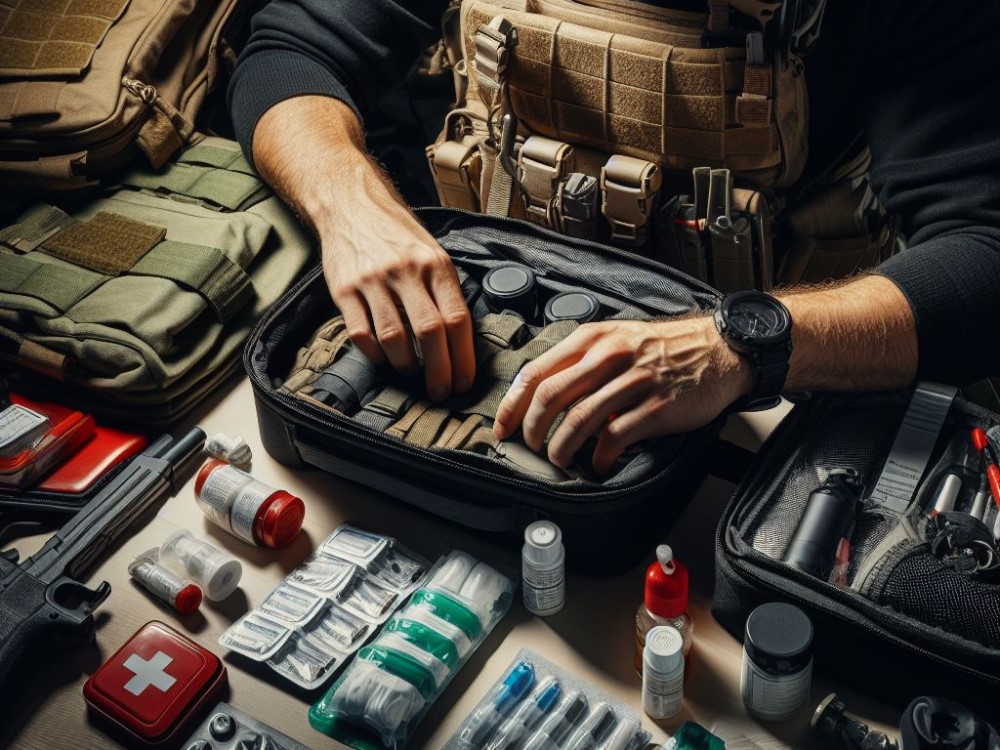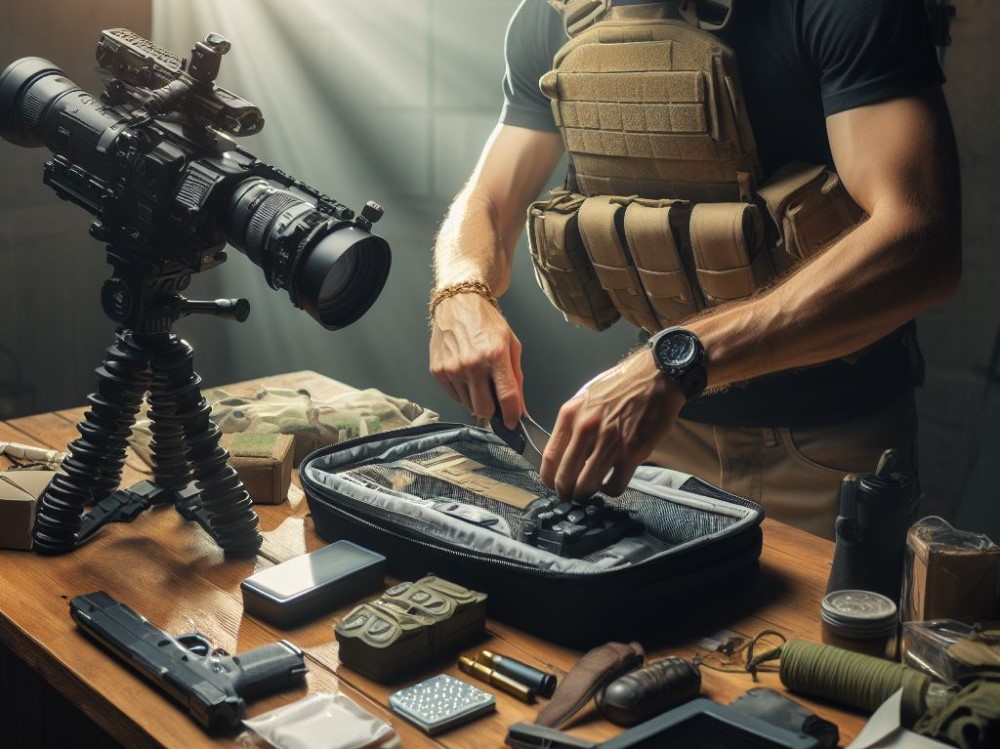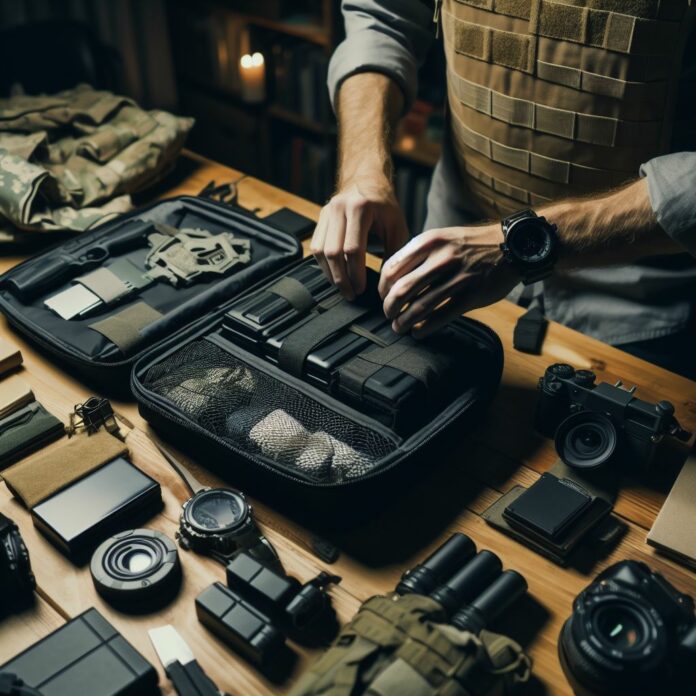Understanding how to organize a tactical backpack is essential for anyone who relies on this type of bag for outdoor activities, military operations, or emergency preparedness. A well-organized tactical backpack ensures that you can easily access the gear and supplies you need when you need them.
To help you optimize the organization of your tactical backpack, here is a comprehensive guide that covers everything from choosing the right backpack to packing techniques and maintenance tips.
A tactical backpack is a specialized backpack designed to accommodate and organize essential gear and equipment for tactical purposes. Whether you are a hiker, camper, hunter, or military personnel, keeping your backpack organized is crucial.
Efficient organization enables quick access to necessary items in high-pressure situations, maximizes comfort and efficiency during use, and ensures that nothing is left behind.
In this guide, we will explore the key considerations for choosing a tactical backpack, essential gear to include, effective packing techniques, and tips for maintaining organization. By implementing these strategies, you can optimize the functionality of your tactical backpack and enhance your overall preparedness and performance in the field.
Choosing the Right Tactical Backpack

Looking to choose the perfect tactical backpack? In this section, we’ll dive into the world of selecting the right tactical backpack, covering important aspects like size, capacity, must-have features, and essential gear.
So, whether you’re a hiker, camper, or outdoor enthusiast, get ready to explore the key factors to consider when picking your ultimate tactical companion. Get ready to make the right choice and enhance your outdoor adventures with the optimal tactical backpack.
Considerations for Size and Capacity
The considerations for size and capacity of a tactical backpack are crucial to ensure it meets your specific needs.
By considering these considerations for size and capacity, you can select a tactical backpack that is well-suited to your size, preferences, and mission requirements, ensuring optimal functionality and comfort.
Features to Look for in a Tactical Backpack
When searching for a tactical backpack, it is important to prioritize durability, multiple compartments, MOLLE webbing, padded straps and back panel, adjustable straps, water resistance or waterproof capabilities, compression straps, laptop compartment, and hydration compatibility.
These features will enhance your tactical experience by offering long-lasting durability, better organization, and comfort. It is essential to consider your specific needs, activities, gear, and environment when making your choice.
Selecting a backpack that incorporates these features will ensure that your gear is protected and that you have a comfortable and organized experience.
Essential Gear for a Tactical Backpack
When it comes to a tactical backpack, it is vital to have the essential gear. This includes:
- Clothing and Personal Items: It’s important to pack lightweight and quick-drying clothing that is suitable for the weather conditions. Don’t forget to include extra socks, underwear, and a hat. Personal hygiene items like a toothbrush, toothpaste, and hand sanitizer are also essential.
- Survival Gear: Carrying essential survival tools such as a multi-tool, firestarter, flashlight, and compass is crucial. Additionally, make sure to include a compact emergency blanket, whistle, and paracord for any emergency situations that may arise.
- Communication and Navigation Devices: It is recommended to bring a reliable communication device like a two-way radio or a satellite communication device. Additionally, a map and a GPS device are necessary for accurate navigation, especially in unfamiliar terrain.
- First Aid and Medical Supplies: Including a comprehensive first aid kit with bandages, antiseptic wipes, pain relievers, and any necessary prescription medications is crucial. Don’t forget to pack bug repellent and sunscreen as well.
- Food and Hydration: To stay fueled and hydrated during your adventure, pack lightweight and high-energy food such as energy bars, trail mix, and dehydrated meals. Additionally, it’s important to have a durable water bottle or a hydration bladder.
By having all of these essential items in your tactical backpack, you can be well-prepared for emergencies and have the necessary supplies for your outdoor activities.
Clothing and Personal Items
When organizing your tactical backpack, it is important to consider the clothing and personal items that you will need. Here is a list of essentials:
- A change of clothes: Pack lightweight and moisture-wicking clothing for different weather conditions.
- Socks and underwear: Bring extra pairs to stay comfortable during your adventures.
- Personal hygiene items: Include travel-sized toiletries such as toothbrush, toothpaste, soap, and hand sanitizer.
- Sun protection: Carry sunglasses, a hat, and sunscreen to shield yourself from harmful UV rays.
- Extra shoes: Pack a pair of sturdy and comfortable shoes in case your current footwear gets wet or damaged.
- Personal documents: Keep your identification, cash, and important contact information in a waterproof bag.
Remember to keep your clothing and personal items organized in separate compartments or packing cubes within your tactical backpack. This will make it easier to locate what you need quickly.
Additionally, regularly check and replenish any items that may expire or run out, such as toiletries or sunscreen, to ensure you are always prepared for your adventures.
Survival Gear
The survival gear that you should consider including in your tactical backpack includes:
- A high-quality multitool, such as a Swiss Army knife, that can perform a variety of functions.
- An emergency shelter, like a lightweight tent or a tarp, to protect you from the elements.
- A fire starter, such as waterproof matches or a compact flint and steel set, to ensure you can make a fire for warmth and cooking.
- Water purification tablets or a portable water filter to ensure you have access to safe drinking water.
- A compact first aid kit, including bandages, disinfectant, and any necessary prescription medications.
- A signaling device, such as a whistle or a mirror, to attract attention in case you need to be rescued.
It is important to carefully select survival gear based on your specific needs and the environment you will be in. Consider factors such as the duration of your trip, the climate, and the potential risks you may encounter.
During a hiking trip in the mountains, John found himself stranded after getting lost on an unfamiliar trail. Fortunately, he had packed essential survival gear in his tactical backpack. With his multitool, he was able to fashion a makeshift shelter using fallen branches and a tarp. He used his fire starter to create a fire for warmth and to boil water that he had purified using his water filter. John also had a first aid kit that he used to treat a minor injury he sustained during his ordeal. Thanks to the survival gear in his backpack, John was able to survive until help arrived.
Communication and Navigation Devices
When it comes to organizing the contents of your tactical backpack, communication and navigation devices are crucial for your preparedness and safety. These devices enable you to stay connected and find your way in any situation.
- Two-Way Radio: Compact and reliable, ideal for team communication or calling for help.
- GPS Device: Portable and accurate, offering location info, maps, and rugged design.
- Compass: Reliable navigation tool for when GPS is unavailable, featuring a clear baseplate and adjustable declination.
- Signal Mirror: Small and precise, perfect for signaling over long distances.
- Whistle: Loud and attachable, essential for emergency signaling.
Pro-Tip: Always familiarize yourself with the operation of your communication and navigation devices before venturing out.
Test them regularly and carry spare batteries or power sources to ensure they are ready for use when needed.
First Aid and Medical Supplies

When it comes to incorporating the keywords “First Aid and Medical Supplies” in the text, it is essential to be prepared for any emergency situation. Here is a list of necessary items to include:
- First Aid Kit: A well-stocked first aid kit is crucial for treating minor injuries and medical emergencies. It should include adhesive bandages, gauze pads, antiseptic wipes, adhesive tape, tweezers, scissors, and a CPR mask.
- Pain Medications: Include over-the-counter pain relievers such as ibuprofen or acetaminophen to alleviate pain and reduce fever.
- Medication: If you have any prescription medications, make sure to pack an adequate supply. Remember to check expiration dates regularly.
- Antiseptic Solution: To clean and disinfect wounds, include an antiseptic solution or wipes.
- Emergency Blanket: A compact emergency blanket can provide warmth and protection from the elements in case of exposure or shock.
- Latex Gloves: Disposable gloves are essential for preventing the spread of infections and protecting yourself while administering first aid.
- Tweezers: Useful for removing splinters, stingers, or debris from wounds.
- Hand Sanitizer: Keep a small bottle of hand sanitizer to maintain proper hand hygiene when soap and water are not available.
By including these first aid and medical supplies in your tactical backpack, you will be well-prepared to handle minor injuries and emergencies during your outdoor adventures.
Food and Hydration
When preparing a tactical backpack, it is crucial to consider your food and hydration needs to sustain your energy and endurance. Here are essential factors to keep in mind:
- Meal Plan: Determine the duration of your excursion and plan your meals accordingly. Ensure a balance of carbohydrates, protein, and fats to meet your energy requirements.
- Dry Food: Pack lightweight and non-perishable food items like energy bars, nuts, and dehydrated meals. These provide essential nutrients and are easy to carry.
- Water: Carry an adequate supply of water to stay hydrated throughout your adventure. The general recommendation is to consume at least 0.5-1 liter of water per hour of physical activity.
- Water Purification: Include a water filtration or purification system, such as water purification tablets or a compact filter, to ensure access to safe drinking water from natural sources.
- Electrolyte Supplements: Consider electrolyte powders or tablets to replenish minerals lost through sweating and maintain proper hydration and muscle function.
- Hydration System: Invest in a hydration bladder or water bottles with convenient access points to ensure easy and on-the-go hydration.
- Snacks: Pack quick and easily accessible snacks like dried fruits, jerky, and trail mix to satisfy hunger and provide a boost of energy during breaks.
- Meal Preparation: Carry necessary utensils, a portable stove, and fuel for cooking meals that require hot water or heating.
By considering your food and hydration needs thoughtfully, you can ensure sustained energy and endurance while engaging in tactical activities.
Organizing the Contents of Your Tactical Backpack
Organizing the contents of your tactical backpack is essential for prepping, camping, or any outdoor adventure. In this section, we’ll dive into the various packing techniques, separating and categorizing items, optimizing weight distribution, and ensuring easy accessibility to quick access items.
Get ready to learn the tips and tricks that will streamline your backpack, making it efficient and tailored to your specific needs. No more rummaging around or carrying unnecessary weight – let’s optimize your backpack to perfection!
Packing Techniques and Strategies
When it comes to packing techniques and strategies for organizing a tactical backpack, it is important to maximize space efficiency and ensure easy access to essential items. Here are some steps to consider:
- Roll your clothing: Roll your clothing items tightly to save space and prevent wrinkles.
- Use compression bags: Utilize compression bags to further minimize the size of your clothing and save space in your backpack.
- Separate items in compartments: Use the different compartments of your backpack to separate and categorize items such as survival gear, communication devices, and first aid supplies.
- Utilize packing cubes: Packing cubes can help keep your items organized and easily accessible.
- Secure loose items: Make use of pouches or small bags to secure loose items and prevent them from shifting during movement.
- Place heavy items close to your back: Distribute weight evenly by placing heavier items closer to your back, which will help improve balance and stability.
- Prioritize quick access items: Keep frequently used items like snacks, water bottles, and navigation devices in easily accessible pockets or compartments.
By incorporating these packing techniques and strategies, you can ensure that your tactical backpack is organized and optimized for your specific needs and requirements while on the go.
Separating and Categorizing Items
When it comes to organizing the contents of your tactical backpack, separating and categorizing items is crucial for easy access and efficient use in different situations.
- Sort by function: Begin by categorizing your items based on their function. Group similar items together such as clothing and personal items, survival gear, communication and navigation devices, first aid and medical supplies, and food and hydration.
- Use separate compartments: Utilize the various compartments and pockets within your backpack to separate different categories of items. This will help you find what you need quickly without having to search through everything.
- Label containers: If you have small containers or bags within your backpack, label them clearly to indicate their contents. This will make it easier to locate specific items, especially in low light or high-stress situations.
- Organize by priority: Place frequently needed items in easily accessible locations, such as the outer pockets or the top of the main compartment. Items that are less frequently used or needed in emergency situations can be stored deeper within the backpack.
- Consider weight distribution: Distribute the weight of your items evenly throughout your backpack to maintain balance and comfort. Place heavier items closer to your back and lighter items towards the outer edges to ensure stability.
- Regularly review and rearrange: Periodically check your backpack to reassess your organization system. Make changes as necessary based on your experiences and evolving needs.
By separating and categorizing items in your tactical backpack, you’ll be able to locate and access them quickly and efficiently, ensuring you are prepared for any situation that may arise.
Optimizing Weight Distribution
To efficiently optimize weight distribution in your tactical backpack, simply follow these steps:
1. Begin by strategically placing the heaviest items closest to your back. This method promotes balance and stability while wearing the backpack.
2. Utilize the designated compartments and pockets within the backpack to evenly distribute the weight. For instance, reserve the bottom compartment for heavier items, while the top compartment can accommodate lighter ones.
3. Take into consideration the accessibility of items. Ensure that frequently used objects such as water bottles or snacks are within easy reach, all while maintaining proper weight distribution.
4. To secure and stabilize the contents, make use of compression straps or internal organizers. This practice minimizes shifting and establishes a well-balanced load.
5. Adjust the shoulder straps and waist belt to evenly distribute weight across your body. Properly tightening these straps ensures that the backpack remains close to your center of gravity, thus optimizing weight distribution.
6. Continuously evaluate and readjust the contents of your backpack throughout your journey to confirm that weight distribution remains evenly balanced.
By effectively optimizing weight distribution in your tactical backpack, you will experience enhanced comfort and reduced strain on your body, enabling you to move efficiently and effectively in any situation.
Accessibility and Quick Access Items
When it comes to efficiently utilizing a tactical backpack, accessibility and quick access items are absolutely crucial. In emergency situations or when immediate access is necessary, you need to be able to reach these items easily.
- Emergency supplies: It’s important to keep your first aid kit, emergency whistle, and fire starter in exterior pockets or compartments for quick retrieval.
- Navigational tools: Make sure you have a compass, map, and GPS device in easily accessible pockets so you can navigate effectively.
- Communication devices: Store your two-way radio, cell phone, or satellite phone in a designated pocket so you can quickly communicate during emergencies.
- Light source: Carry a flashlight or headlamp in an exterior pocket for easy access to lighting in low-light or emergency situations.
- Snacks and hydration: Keep energy bars or snacks in easily reachable side pockets for quick fueling. Your water bottles or hydration bladder should also have designated compartments for easy access.
- Multi-tool or knife: Store a versatile tool, like a multi-tool or knife, in a convenient pocket. You never know when you’ll need it, so it should be readily accessible.
By strategically placing these accessibility and quick access items in your tactical backpack, you’ll be able to respond swiftly and efficiently in critical situations.
Tips for Maintaining Organization

Keeping your tactical backpack organized is essential for any outdoor enthusiast. In this section, we will uncover valuable tips that will help you maintain the perfect order in your gear.
From conducting regular inventory and inspection to repacking after each use, we will discuss practical strategies that ensure everything has its place.
Additionally, we will explore the effectiveness of labeling and color coding systems in streamlining your pack. Get ready to optimize your backpack organization and enhance your outdoor adventures!
Regular Inventory and Inspection
Regular inventory and inspection are crucial for maintaining organization in your tactical backpack. By conducting regular checks, you can ensure that you have the necessary items and that everything is in working order.
- Check your inventory: Regularly go through your backpack to take inventory of the items you have. This will help you identify any missing or damaged items that need to be replaced.
- Inspect equipment: Take the time to inspect all your gear for any signs of wear or damage. Check for broken zippers, torn fabric, or any other issues that may affect the functionality of your equipment.
- Test electronics: If you have any electronic devices in your backpack, such as communication or navigation devices, make sure to test them regularly to ensure they are in working order and that the batteries are charged.
- Check expiration dates: For items like first aid supplies and food, check the expiration dates and replace any items that have expired.
Pro-tip: Create a checklist of all the items in your backpack and mark off each item as you inspect it. This will help you stay organized and ensure that nothing is overlooked during the regular inventory and inspection process.
Repacking After Each Use
Repacking after each use is crucial to maintaining organization in your tactical backpack. To ensure your gear stays organized and ready for your next adventure, follow these steps:
- Empty your backpack entirely and remove all items.
- Inspect each item for any signs of damage or wear and tear.
- Thoroughly clean and dry any dirty or wet items before putting them back into the backpack.
- Categorize your gear into different groups, such as clothing, survival gear, communication devices, first aid supplies, and food and hydration.
- Put each item back into the backpack in a logical and systematic order, ensuring that heavier items are placed at the bottom for better weight distribution.
- Take advantage of the compartments and pockets within the backpack to keep smaller items easily accessible and to prevent them from being lost or tangled.
Pro-tip: Utilize clear, waterproof bags or pouches to store and separate items within your backpack. This will enable you to quickly locate and retrieve specific items without unpacking everything.
Labeling and Color Coding Systems
Labeling and color coding systems are crucial for maintaining organization in a tactical backpack.
Implementing efficient organization methods is crucial for optimizing your backpack’s storage:
- Labeling System: Employ tags or stickers to clearly mark items’ contents or purposes, facilitating quick retrieval when needed. Utilize labels for clothing, survival gear, communication devices, and medical supplies.
- Color Coding System: Categorize items using colored pouches, bags, or tape. Assign colors such as red for first aid supplies, green for food and hydration, and blue for communication and navigation devices. Ensure clear labels and durable materials to prevent fading or peeling.
- Consistency and Maintenance: Maintain consistency throughout your backpack’s organization system, making it easily understandable for anyone accessing it. Regularly review and update your color coding system to accommodate new items or gear changes.
By utilizing both a labeling system and a color coding system, you can effectively organize your tactical backpack and swiftly locate the items you need during various situations or emergencies.
Practice and Real-Life Simulations
When it comes to organizing a tactical backpack, practice and real-life simulations are crucial to ensure efficiency and preparedness. Here’s why:
- Enhance proficiency: Engaging in practice and real-life simulations helps improve your skills and proficiency in organizing and accessing items in your tactical backpack.
- Cultivate quick decision-making: Through simulations, you can develop the ability to make quick decisions and efficiently adapt to unexpected situations, ensuring that you can access the necessary equipment when needed.
- Boost situational awareness: By practicing and simulating real-life scenarios, you can enhance your situational awareness, enabling you to effectively prioritize and access essential items in your backpack based on the situation at hand.
- Improve muscle memory: Regular practice and simulations allow you to develop muscle memory, ensuring that your movements and actions in accessing items become automatic, saving you precious time and effort in critical situations.
- Test gear and organization system: Engaging in real-life simulations provides an opportunity to test your gear and organization system, allowing you to identify any flaws or improvements that need to be made for better efficiency.
- Build confidence: Through practice and real-life simulations, you can build confidence in your ability to organize and access items in your tactical backpack, giving you peace of mind in challenging situations.
Frequently Asked Questions: How to Organize a Tactical Backpack
How should I organize a tactical backpack for a combat situation?
When organizing a tactical backpack for a combat situation, it is important to prioritize essential items like a life-saving kit, field manual, hydration gear, and navigation tools. Place these items in easily accessible outside compartments or pockets for quick retrieval during high-pressure situations.
What makes a tactical backpack a versatile option for camping or backpacking trips?
A tactical backpack is a versatile option for camping or backpacking trips due to its durable construction using high-end fabrics like ballistic nylon. It offers multiple storage sections and outside compartments for organizing gear. Additionally, it features a militaristic feel with MOLLE webbing, making it adaptable for attaching additional equipment.
What should I consider when packing medium-weight items in a tactical backpack?
When packing medium-weight items in a tactical backpack, make sure to place them in the middle section of the backpack. This will provide balance and stability. Examples of medium-weight items include utility & repair kits, climbing equipment, and hydration gear.
How can I create space for securing valuables at the top of the tactical backpack?
To create space for securing valuables at the top of the tactical backpack, start by cushioning the bottom of the bag with soft towels or bulky objects. This creates a foundation for packing and prevents puncturing anything on top. Then, pack heavier items at the bottom and use shoulder straps or clothing to pad and protect them.
What is the proper organization for essential and accessory items in a tactical backpack?
Essential items, such as a life-saving kit and water purification supply, should be prioritized and placed in easily accessible pockets or compartments. Accessory items, like ammunition clips and anti-antidote serums, can be packed in other compartments and can be recycled or left behind if necessary.
How can I properly waterproof items in a tactical backpack?
Answer: To waterproof items in a tactical backpack, consider using waterproof bags or plastic bags to protect sensitive items from bad weather. Place items inside these bags before packing them in the backpack. This will help keep them functional and dry during outdoor activities.

